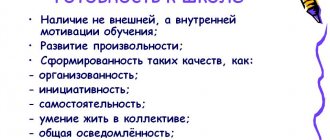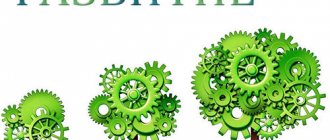In Russian psychology, not much is said about sensitive periods of child development. The definition states that age-related sensitivity is “an optimal combination of conditions inherent in a specific age period for the development of certain mental properties or processes.” At the same time, it is emphasized that “premature or delayed training in relation to the period of age-related sensitivity may not be effective enough, which adversely affects the development of the psyche.”
Agree, nothing is clear. Let's turn to additional sources, namely what Maria Montessori wrote about this.
So, sensitive periods are called periods of special receptivity of children to certain types of activities and to methods of emotional response, behavior, etc. That is, in fact, the child will never learn anything with such ease as in the corresponding skill sensitive period. The main task of parents is to monitor their child, since sensitive periods are both universal and individual. It is important to catch the right moment.
Why do we need knowledge about sensitive periods of baby development?
It’s simple: to prepare the appropriate environment and give the child the opportunity to promptly exercise his senses, social life skills, speech, etc. The thing is that sensitive periods last a certain time and pass irrevocably, they cannot be returned.
Parents cannot in any way influence the sensitive period itself, but they are able to:
- know the characteristics of each period, so as not to fight the natural nature of the child;
- anticipate the onset of the next sensitive period and have time to prepare the appropriate environment so that the child has what he especially needs at this particular moment.
Sensitive periods of development are universal
, that is, they arise during the development of all children, regardless of race, nationality, pace of development, geopolitical, cultural differences, etc.
Sensitive periods of development vary from person to person
, when it comes to the time of their occurrence and duration in a particular child. Biological age may not correspond to psychological age.
Read also[edit | edit code]
- Assessment of physical development in children
- Development of physical abilities
- Physical development of children
- Development of strength abilities
- Rapidity
- Physical endurance and performance
- Development of coordination abilities
- Development of flexibility in children
- Determination of training and competition load
- Functionality of the respiratory system
- Functionality of the cardiovascular system
- Assessing the psychological state of an athlete (tests)
- Sports genetics: genetic tests for athletes
- Development of physical qualities
Sensitive period of speech development
Lasts on average from 0 to 6 years.
Under one year of age:
Children learn to imitate sounds.
Around 1 year of age:
The baby consciously pronounces the first word; for the first time in his life there is a verbal expression of thought.
At about 1.5 years of age:
The baby begins to express his feelings and desires. It is important to understand that the child is able to perceive the grammatical norms of the language and is able to formulate a sentence grammatically accurately.
What does it mean?
At the age of 2.5 - 3 years
The baby often talks to himself. This is an opportunity to eavesdrop on his thoughts, see the logic or illogicality of thinking in them.
At the age of 3.5 - 4 years
: the child actively expands his vocabulary, enjoys talking, composing and telling stories.
Recommendation:
With a child, there is no need to lisp and simplify the language to “childish”. On the contrary, he needs to be introduced to the richness of his native language, its diversity.
Children of this age are keenly interested in the symbolic designation of sounds - letters, enthusiastically trace letters from rough paper, etc.
Therefore, at the age of 4.5 - 5 years
It seems completely natural that the child begins to write individual words and numbers of his own free will and tries to write his name.
Finally, at about 6 years
the child is ready and wants to learn to read.
If a child has to do something outside the framework of the corresponding sensitive period, that is, under duress (learn to read, write, etc.), then he comes to the result later or does not come at all.
Sources
- Talan DA., Mower WR., Lovecchio FA., Rothman RE., Steele MT., Keyloun K., Gillard P., Copp R., Moran GJ. Clinical Pathway With Single-Dose Long-Acting Intravenous Antibiotic Reduces Emergency Department Hospitalizations of Patients With Skin Infections. // Acad Emerg Med - 2021 - Vol - NNULL - p.; PMID:33780567
- Gao XD., Gong Y., Chen XJ., Li YK. Trophic niche and gut microbiota of Dosidicus gigas in the eastern equatorial Pacific Ocean. // Ying Yong Sheng Tai Xue Bao - 2021 - Vol32 - N3 - p.1087-1095; PMID:33754576
- Walker R., Eriksson A., Ruiz C., Newton T.H., Casalegno F. Stabilization of cultural innovations depends on population density: Testing an epidemiological model of cultural evolution against a global dataset of rock art sites and climate-based estimates of ancient population densities. // PLoS One - 2021 - Vol16 - N3 - p.e0247973; PMID:33730059
- Christ AJ., Bierman PR., Schaefer JM., Dahl-Jensen D., Steffensen JP., Corbett LB., Peteet DM., Thomas EK., Steig EJ., Rittenour TM., Tison JL., Blard PH., Perdrial N., Dethier DP., Lini A., Hidy AJ., Caffee MW., Southon J. A multimillion-year-old record of Greenland vegetation and glacial history preserved in sediment beneath 1.4 km of ice at Camp Century. // Proc Natl Acad Sci USA - 2021 - Vol118 - N13 - p.; PMID:33723012
- Zhang D., Zhang C., Li X., Zhao J., An C., Peng C., Wang L. Thin-section computed tomography findings and longitudinal variations of the residual pulmonary sequelae after discharge in patients with COVID-19: a short-term follow-up study. // Eur Radiol - 2021 - Vol - NNULL - p.; PMID:33704519
- Jia D., Sun C., Zhou Z., Zhao Q., Yu Q., Liu G., Wang Y. The Role of Creative Publicity in Different Periods of the COVID-19 Outbreak in China: Taking the Creative Publicity of Chinese Poetry as an Example. // Front Psychol - 2021 - Vol12 - NNULL - p.600818; PMID:33643133
- Tsan L., Décarie-Spain L., Noble EE., Kanoski SE. Western Diet Consumption During Development: Setting the Stage for Neurocognitive Dysfunction. // Front Neurosci - 2021 - Vol15 - NNULL - p.632312; PMID:33642988
- Diao L., Zhang H., Liu B., Dai C., Zhang Y., Dai Q., Bi X., Zhang L., Song C., Feng Y. Health risks of inhaled selected toxic elements during the haze episodes in Shijiazhuang, China: Insight into critical risk sources. // Environ Pollut - 2021 - Vol276 - NNULL - p.116664; PMID:33609903
- Anesi GL., Jablonski J., Harhay MO., Atkins JH., Bajaj J., Baston C., Brennan PJ., Candeloro CL., Catalano LM., Cereda MF., Chandler JM., Christie JD., Collins T ., Courtright KR., Fuchs BD., Gordon E., Greenwood JC., Gudowski S., Hanish A., Hanson Iii CW., Heuer M., Kinniry P., Kornfield ZN., Kruse GB., Lane-Fall M., Martin ND., Mikkelsen ME., Negoianu D., Pascual JL., Patel MB., Pugliese SC., Qasim ZA., Reilly JP., Salmon J., Schweickert WD., Scott MJ., Shashaty MGS. , Sicoutris CP., Wang JK., Wang W., Wani AA., Anderson BJ., Gutsche JT. Characteristics, Outcomes, and Trends of Patients With COVID-19-Related Critical Illness at a Learning Health System in the United States. // Ann Intern Med - 2021 - Vol - NNULL - p.; PMID:33460330
- Chang-Chan DY., Ríos-Tamayo R., Rodríguez Barranco M., Redondo-Sánchez D., González Y., Marcos-Gragera R., Sánchez MJ. Trends of incidence, mortality and survival of multiple myeloma in Spain. A twenty-three-year population-based study. // Clin Transl Oncol - 2021 - Vol - NNULL - p.; PMID:33433836
Sensitive period of perception of order.
This sensitive period is not described in detail anywhere except in the works of Maria Montessori: “The true essence of the mind is to give order to the chaotic impressions emanating from the surrounding world.”
This period lasts from 0 to 3 years, and the stage of its highest intensity occurs around 2 - 2.5 years.
“For a child, order is the same as for us the floor on which we walk, and for a fish the water in which it swims. In early childhood, the human spirit takes from the surrounding world the orienting elements that are needed for subsequent mastery of the surrounding world,” wrote Maria Montessori.
It is very important that the life of a child aged 0 to 3 years be accompanied by an external routine. His inner peace in later life—order in his thoughts and actions—depends on how orderly the environment is during this period.
Montessori emphasizes that at the age of 2 - 2.5 years the child experiences a characteristic love, or rather, a real passion for maintaining the order that is familiar to him. He needs everything to be repeated and predictable in his home, in his daily routine and in the behavior of adults towards him.
Text of the book “Human Physiology. General. Sports. Age"
3.6.2. Development of physical qualities The age period from 10 to 17–19 years is characterized by the achievement of maximum development of most physical qualities - flexibility, speed, agility, strength, speed-strength capabilities, as well as large changes in endurance, which reaches its maximum development somewhat later - by 20–25 years.
Middle and high school age is especially favorable for physical education, as it corresponds to the manifestations of many sensitive periods in the development of physical qualities, i.e., periods that are most sensitive to training influences (see Fig. 38).
One of the earliest is the physical quality of flexibility - joint mobility.
Improving flexibility, which begins in preschool and primary school age, continues in middle school age. The greater the length of the body parts, the greater the flexibility of adolescents. Flexibility reaches its highest values by the age of 15; without further training it begins to decline. Girls have better flexibility than boys.
A very favorable period for the development of dexterity
observed from 7 to 14 years (with a slight deterioration in this quality at the peak of puberty). The maturation of the inferior parietal tertiary areas of the cortex contributes to the improvement of intersensory integration and sensorimotor relationships, the formation of ideas about the “body diagram” and “space diagram.” As a result, spatial orientation of movements and, as a result, bodily and object dexterity improves.
As the frontal tertiary areas of the cerebral cortex mature, new opportunities for various manifestations of dexterity appear: the ability to form new movements in unusual conditions develops, the analysis of the current and future situation improves, the introduction of sensory corrections into motor programs, and the temporary assessment of performed actions. The development of dexterity is facilitated by the improvement of extrapolation processes. After the age of 35, dexterity deteriorates, especially in old age.
From 10 to 15 years, various speed quality indicators improve sharply,
reaching adult values by the age of 15 (see Table 5) and remaining at this level until approximately 35 years. In the adolescent’s central nervous system, the speed of nervous processes (lability of nervous tissue) increases and the mobility of nervous processes, the rate of change in the processes of excitation and inhibition, increases. This helps to increase the speed of information processing in the cerebral cortex. By the age of 12, the time for a simple motor reaction noticeably shortens, and by the age of 14, the time for a complex reaction with choice. Improving the central regulation of movements and increasing the excitability and lability of the muscular system contribute to the acceleration of motor acts. By the age of 15, the tapping test (50–60 beats per 10 s) and maximum running speed reach adult levels. Speed parameters improve especially significantly in boys.
The age of 11–14 years is sensitive for the development of speed and strength capabilities.
During this period there is the greatest increase in jumping ability, sharpness of blows and throws. By the age of 14-15 years, the greatest height and distance of jumps is achieved, especially in boys (see Fig. 48 and Table 20).
Muscle strength
increases at a slow pace until the age of 11. Then there is a slowdown in the rate of its growth, associated with the development of the prepubertal period (11–13 years in boys) and the beginning of restructuring processes in the body. At the age of 14, Losla begins to experience a significant increase in muscle strength (Fig. 57), especially pronounced in boys and associated with increased secretion of male sex hormones (androgens). The deadweight strength of boys at 12 years old averages 50–60 kg, at 15 years old – 90–100 kg, at 18 years old – 125–130 kg.
Rice. 57. Maximum hand strength in untrained individuals
In skeletal muscles, myofibrillar hypertrophy is observed, reflecting the processes of enhanced synthesis of contractile proteins (actin and myosin) in myofibrils. Under the influence of the development of fast motor neurons in the nervous system, changes occur in the composition of muscle fibers - the volume of fast and powerful type II-b glycolytic fibers noticeably increases.
The sensitive period for the development of strength quality is between 14 and 17 years of age. At the age of 18–20 years, muscle strength reaches its maximum values for an untrained adult. Typically, hand strength in men is about 70–75% of body weight, and in women it is approximately 50–60%. In the absence of special training, strength remains at this level until approximately 45 years of age. In adolescence, the topography of muscle strength characteristic of an adult body is established, but correction is made to it by the specifics of muscle training.
Endurance to long-term cyclic work develops later than other qualities.
moderate power.
The sensitive period of its development occurs at the age of 15–20 children, when the functions of the respiratory and cardiovascular systems, ensuring aerobic functioning, mature sufficiently. At the age of 20–25, this quality reaches a high level of development and persists longer than others in human ontogenesis (up to approximately 55 years or more). Static endurance
(Table 30) increases less than dynamic endurance. It decreases during puberty and then increases, especially at the age of 18–20 years.
Table 30
Age-related dynamics of muscle strength and static performance in women under static stress
(according to: E.A. Gorodnichenko, 1983)
In adolescence, based on the significant development of various qualitative characteristics of motor activity, specialization in many sports and achievement of high sports results is possible. Only in sports that require the utmost development of endurance (long and ultra-long distance running, cross-country skiing, etc.), the highest achievements appear at a later age - at 20–35 years.
3.6.3. Features of the energy of muscle activity and reactions of the autonomic systems to physical activity
In a growing and developing organism, energy expenditure on motor activity accounts for about half of daily energy expenditure.
In boys aged 14–15 years, daily physical activity increases by more than a third, compared with 8–9 year old children. At the age of 11–15, teenagers take 20–30 thousand steps per day. Their daily energy expenditure reaches 2200 kcal at the age of 10–12 years, and approximately 3000 kcal at the age of 13–15 years. At rest, the main energy expenditure occurs in the organs with the most intense metabolism - the brain, liver, kidneys, and during work - in the working muscles. This is due to the fact that with an increase in muscle growth and the level of motor activity, energy expenditure in adolescents increases sharply.
The main development in adolescents is achieved by the processes of aerobic energy production.
A rapid increase in muscle mass, the predominance of slow fibers of the oxidative type in the muscles, an increase in the number of mitochondria and myoglobin in the muscles, increased activity of oxidative enzymes, improved utilization of oxygen brought by the blood, as well as improved regulatory mechanisms of the cardiovascular and respiratory systems - all this leads to
increased aerobic capacity of the body and MIC value.
If in the prepubertal period and in the II stage of puberty in adolescents aerobic capabilities are still small, then at the III stage of puberty (for girls at 12–13 years old, for boys at 13–14 years old) their sharp increase is observed. At this stage, the increase BMD (l/min) in boys is approximately 28%, in girls -17%.
In young athletes, the increase in VO2 max is even greater (Fig. 58). The absolute values of MIC reach their maximum values at the age of 14–15 years.
Rice. 58. Aerobic capacity of boys 8-15 years old
(modified from: S.B. Tikhvinsky, 1972)
Adolescents during this period are well adapted to perform aerobic work – cyclic exercises of moderate power (about 70% of MOC). Performing loads of maximum and submaximal power (90-100% of MOC) is difficult for them to tolerate, since at this age the anaerobic capabilities of the body are not sufficiently developed.
The relative values of MIC (ml/min/kg) during middle and high school age (10–17 years) practically do not change
(Fig. 59). This is due to the fact that annual increases in aerobic capacity do not exceed increases in body weight. However, in young athletes who have better developed skeletal muscles that form aerobic energy supply, the relative values of VO2 max are higher than in peers who do not go in for sports.
Rice. 59. Age-related dynamics of anaerobic capacity (oxygen debt, ml/kg) and the relative value of MIC (ml/min/kg) in boys 9-17 years old
The relative values of MIC in the female body are lower than in the male body. In girls over 8 years of age, the relative values of BMD at middle school age are lower than in boys by 12–21%, and at high school age – by 33–39%. This is explained by the fact that girls have a larger proportion of the fat component in their body composition, which consumes a small amount of energy.
Stable relative MIC values are very important in terms of selection.
Since they do not change during training and already at 9-10 years of age correspond to adult indicators, they should be used as informative prognostic criteria for selecting children in youth sports schools, especially in sports that require the development of endurance.
After the age of 14, the implementation of a new stage of the genetic program of ontogenesis begins. The formation of fast motor neurons in the central nervous system and the development of fast and powerful glycolytic muscle fibers in skeletal muscles occur.
By stages IV–V of puberty (15–18 years), fast fibers already occupy about 50% of the muscle mass by volume.
The composition (composition) of muscle fibers characteristic of each individual is established. With the appearance of glycolytic fibers, the anaerobic capabilities of the growing organism rapidly develop
(see Fig. 59). The contractile activity of these fibers does not depend on the work of the oxygen transport system (blood, cardiovascular and respiratory systems), since they receive energy in oxygen-free conditions. As a result, the adaptation of boys and girls to anaerobic work increases - to performing cyclic work in the zone of maximum and submaximal power, strength and speed-strength exercises.
The power of work performed increases from 11 to 16 years by more than 200% (from 7 to 11 years the increase in work power is only 30%). The volume of work performed at maximum power increases by 50% at 10 years of age compared to 7 years of age, and by 300–400% at 14–15 years of age.
Due to the achieved high level of MPC and improved coordination processes in the muscular and vegetative energy supply systems, the aerobic performance of young men also increases - in zones of high and moderate power.
However, the efficiency and effectiveness of their work have not yet reached adult levels.
The efficiency of work performed at the MPC level at 14–15 years of age is only 65–70% of the adult level, and the recovery process is much longer. In 17-year-old boys, the recovery time is 2 times longer than in 20-year-olds with the same work performed.
Clearly expressed hormonal and autonomic changes accompany physical activity in children of middle and high school age.
Adaptation to specific exercises is reflected in systematically trained children in more pronounced pre-start changes
compared to children who do not play sports. Pre-launch tuning develops most easily in adolescents and young men characterized by a sanguine temperament, then in choleric and phlegmatic people. During puberty in adolescents, due to the high excitability of the nervous system, pre-launch fever is especially pronounced.
Run-in period
both at the age of 7-10 years and at the age of 15-18 years it is characterized by an initial sharp increase in indicators of the cardiovascular and respiratory systems (by 42.5%), followed by a slow increase to the required working level.
The duration of a steady state
at constant power (or optimal state at variable power) is shorter than in adults, and fatigue occurs faster.
Rapid onset of fatigue
in particular, due to low tolerance to oxygen deficiency.
The maximum oxygen debt in adolescents is less than in adults:
at 9-10 years old it is only 0.8-1.2 l, at 12-14 years old - 2-2.5 d (for untrained adults - 6-10 l ). At 13 years of age, the relative oxygen debt (per 1 kg of body weight or 1 m2 of body surface) is approximately equal to 60–70% of the corresponding figure in adults.
In the blood system
in children of middle and high school age, during physical activity, phase II of myogenic leukocytosis often occurs (1st neutrophilic), while in adults, under the same loads, only phase I (lymphocytic) is observed. Large muscle loads cause inadequate blood reactions in adolescents - they reduce the body's immunity. At the same time, inhibition of activity and a decrease in the number of T-lymphocytes in the blood are observed, the amount of the immune protein interferon gamma decreases, and the phenomenon of disappearing antibodies appears.
Due to the incomplete growth of cardiac muscle mass and heart volume in adolescents, an increase in systolic blood volume
does not yet reach adult values. Even with the maximum increase in systolic volume during work, its values are only 2 times higher than the resting level, and in adults - 2.5 times. At the age of 8–9 years, the maximum values of systolic volume are 70 ml, at 10–11 years old – 80 ml, at 14–15 years old – 100–120 ml, in men 20–22 years old – 140 ml.
The relatively small volume of blood entering the bloodstream per beat explains that the increase in minute blood volume
in adolescents, it still largely depends on the predominant increase
in heart rate.
Only after 15-16 years of age does the magnitude of heart rate shifts during exercise decrease somewhat. The value of IOC in adolescents gradually increases: at 10–12 years old it is 3.2 l/min, at 13–16 years it is 3.8 l/min, in adolescence the IOC approaches the adult level (in adults IOC 4.5– 5 l/min).
The lack of efficiency of regulatory processes during puberty in adolescents is reflected especially noticeably in the reactions of blood circulation to static loads.
If with static tension of small muscle groups the reactions of the cardiovascular system are quite effective, then with static tension of large muscle groups in a vertical position they are clearly insufficient - instability of venous tone and a protracted recovery period are observed. This reflects the low endurance of adolescents to such static loads.
In untrained adolescents 14–15 years old, the optimal increase in IOC is observed at a work power of no more than 40–50% of MOC, and the optimal increase in minute respiratory volume is at 70% of MOC, i.e., when working at moderate power, changes in the respiratory and cardiovascular systems are most effective.
With increasing age, the functional reserves of the respiratory system increase.
When working at the level of MOC, the value of MOD (l/min) increases compared to the resting state at the age of 8–9 years by 7–8 times, at 10–11 years – by 9–11 times, at 16–18 years at 10–12 once.
However, the efficiency of breathing in adolescents and, to a certain extent, young men is still low.
Despite the increased operating level of pulmonary ventilation, alveolar air is less saturated with oxygen during inhalation in adolescents than in adults. This is due to a less deep tidal volume, a larger relative volume of harmful space, less endurance of the respiratory muscles, delayed growth of the chest (and, accordingly, insufficient vital capacity), and immaturity of regulatory processes.
To the imperfection of gas exchange in the lungs is added the low oxygen capacity of the blood and less efficient gas exchange in the tissues, where the coefficient of oxygen utilization is low,
that is, a small amount of oxygen passes from arterial blood into tissues and a significant part of it is carried back by venous blood. Adolescents have a less favorable ratio of oxygen supply to the lungs and its consumption by tissues: for a child 8–9 years old and a teenager 15–16 years old, this ratio is 6:1, and for an untrained adult it is 5:1 and for a trained adult – 4 :1. In adults, each liter of oxygen when working at the level of MOC is extracted from 25 liters of air, and in a teenager - from 35 liters, i.e., the required lung work is almost 1.5 times greater than in adults.
At the same time, the oxygen demand for work in adolescents and young men is higher than in adults
for the same load. The noted features of satisfying oxygen demand indicate the importance of regulating physical activity in adolescents and young men.
Increasing stress, especially during puberty, can lead to serious consequences.
In girls 10–11 years old, under heavy loads, a discrepancy between the electrical and mechanical systole of the heart occurs as a result of a violation of metabolic processes in the myocardium. Under heavy loads, pathological involution of the thymus gland occurs, and impaired immunity leads to increased morbidity in children. The secretion of somatotropic hormone is inhibited, which leads to growth retardation, as well as hormones of the adrenal cortex. In girls aged 11–16 years, the secretion of sex hormones is especially inhibited, and the formation and stabilization of the GMC is disrupted.
In connection with what was noted in the process of physical education, careful dosing and individualization of loads is required,
monitoring the current condition of children.
A gradual increase in physical activity in accordance with the age-related functional capabilities of the developing organism will ensure a rational course of the adaptation process, maintaining the health of children and the growth of their sports skills. 3.6.4.
The influence of sports training on the development of body functions and the dynamics of performance. Systematic physical exercises cause significant changes in the structure and functions of the body, increase its functionality and contribute to the development of the physical qualities of young athletes.
In the cerebral cortex of a training teenager, there is a general increase in the functional state (excitability and lability) of cortical neurons, and indicators of higher nervous activity improve - strength, balance and mobility of nervous processes.
The resulting increase in the speed of the brain is reflected in its electrical activity by an increase in the frequency of the main resting rhythm - the alpha rhythm of the EEG. Young athletes aged 14–15 years with a higher alpha rhythm frequency (11–12 oscillations/s) have a higher tapping test frequency and higher brain capacity than children of the same age with a lower alpha rhythm frequency (8 –9 oscillations/s).
As special performance increases, specific changes occur in the young athlete’s central nervous system, reflecting the formation of new motor skills. Nerve cells begin to work more rhythmically and stably. The activity of individual neurons is synchronized with neighboring neurons and with neurons in a number of distant areas of the cortex necessary to participate in the control of specific movements. This creates special cortical functional systems,
reflecting in their composition the specifics of the mastered motor skill (see Fig. 32), and during cyclic work - the pace of movements (“marked rhythms” of the EEG).
The manifestation of these cortical functional systems in the EEG increases in young athletes as age and sports skill increase, and their features appear not only during work, but also during its mental execution (imagining the movement), as well as in the pre-start state, demonstrating the degree of mastery of the skill and specific pre-tuning of the brain (Table 31).
In the process of adaptation to physical activity, the regulation of blood vessels in the brain improves.
Adolescents and young men, adapted to significant static stress during weightlifting, have a more stable and high blood flow in the brain than their peers who are not prepared for such work.
Table 31
Dynamics of intercentral connections in the cerebral cortex of the same young figure skaters during 5 years of training[1]1
The average number of high 0.7–1.0 potential correlations in the EEG of an individual athlete is shown as a percentage of the total number of calculated correlations.
[Close]
(based on: V.S. Kapustin, 1984)
High mental stress negatively affects the ability to maintain stable performance. For example, a higher emotional and information load in individual tactical lessons compared to technical lessons for young fencers leads to a more rapid development of fatigue and significantly reduces work to failure.
At the same time, the higher the qualifications of young athletes, the greater the ability they have to voluntarily mobilize functional reserves to overcome fatigue,
especially in highly motivated work environments. At the same time, they perform a significantly greater amount of work than their untrained peers, but experience greater fatigue and need longer rest.
The high ability to volitionally overcome developing fatigue in young athletes is ensured by more powerful working dominants in the central nervous system, high excitability of the sympathetic nervous system, the presence of significant hormonal reserves (for example, the amount of daily secretion of adrenaline and norepinephrine is many times higher than the norms of untrained children) and significant production nerve cells stimulating neuropeptides.
Already at the age of 12-14, young athletes are clearly differentiated by a whole complex of psychophysiological characteristics into two different types, which absolutely must be taken into account when choosing a genetically adequate sport, style of competitive activity and role of the athlete
(attacker or counterattacker in boxing, striker or defender in football, striker or point guard in volleyball, etc.).
At the very initial stages of sports training, one should also carefully determine the athlete's leading arm and leg
for an adequate choice of an armed hand in fencing, tennis, hockey, a right-handed or left-handed stance in boxing, kicking legs in football, taekwon-do, kickboxing, etc. Inadequate choice leads to a slowdown and stop in the growth of sports skills, creates tension in the body associated with the organization of compensatory reactions, and threatens the athlete’s health.
Physical exercise has a positive effect on the development of sensory systems.
Young athletes are distinguished by the accuracy of kinesthetic sensations, which are higher on the most trained muscles and joints. When reproducing given angles of flexion in the elbow joint (without visual control), fencers make 3 times fewer errors, and skiers make 2.5 times fewer errors when flexing the knee joint than untrained adolescents. Young basketball players almost accurately reproduce the angle of rotation in the wrist joint with their eyes closed. The range of accurately reproducible (without visual control) specified angles in the shoulder and hip joints is much wider among highly qualified young athletes specializing in taekwon-do than among untrained peers.
Young football players have a wider field of vision. Improving the search function of the eye allows young wrestlers, boxers, and teenagers specializing in team sports to instantly grasp the most significant information and quickly respond to it. Highly skilled young skaters demonstrate excellent vestibular stability, performing up to 500 rotations in a 55-minute workout without any loss of coordination. Lowering to the floor after spinning on the “Vertical” setting, they can almost instantly assume a stable position, while for untrained teenagers this “time of indecision” takes several seconds.
In middle and high school age, sports training has a particularly significant effect on the development of the musculoskeletal system.
In the most loaded bones of the skeleton, the thickness and density of bones and the degree of their mineralization increase noticeably.
Muscle mass and strength predominantly increase in the most trained muscles,
creating a specific topography of muscle strength characteristic of each sport.
During long-term sports training, the volume of fast glycolytic fibers of type ll-b (anaerobic) increases
. It is also possible that under the influence of speed-strength physical exercises, many intermediate type fibers (II-a, oxidative, aerobic) acquire the properties of type II-b (glycolytic) fibers. It has been shown that in 12-year-old athletes the volume of fast and powerful muscle fibers in skeletal muscles significantly exceeds this figure in non-exercising adolescents (59% versus 51%).
These features correlate in young athletes with a higher (3 times) concentration of the hormone testosterone in the blood at rest (5.8 nmol/l versus 1.8 nmol/l) and a higher concentration of lactate during anaerobic work.
An increase in muscle strength is often accompanied by an excessive increase in tension tone
without sufficient ability to relax muscles. Such ratios reduce the amplitude of movements, prevent the growth of muscle performance, and lead to rapid muscle fatigue. In 13-14 year old football players, the greatest increase in tone amplitude was noted in the quadriceps femoris muscle due to a more pronounced increase in tension tone, and an improvement in relaxation indicators occurred only after 16 years, when moving to the masters team. Such changes are the result of increased isometric strength training without the necessary attention to relaxation exercises.
An increase in lean body mass is accompanied by a decrease in fat content in young athletes ,
especially noticeable in representatives of winter sports (up to 7–8% of body weight). The lower their body fat percentage, the higher their physical performance.
Systematic training has an ambiguous effect on the rate of growth and development of children’s bodies.
For retardant girls involved in gymnastics, long-term training increases the lag of their biological age from their passport age (less than standard body mass and length, later appearance of menarche, etc.). Only by the age of 16 do they begin to catch up with their peers. In contrast, accelerated swimmers increase their rate of development (the manifestations of acceleration increase); at the age of 13, they are 2–3 years or more ahead of their peers in many indicators. Many young basketball players at the age of 13 reach the levels of 17-18-year-old boys, 4-5 years ahead of their peers.
Restructuring of the somatic functions of the body is accompanied by changes in vegetative indicators in young athletes.
The development of cardiac muscle mass and an increase in heart volume increase the aerobic capacity of the body. In the respiratory system, under the influence of long-term training sessions, the efficiency and economy of the respiratory function increases, the vital capacity increases
(123% against the required values), which ensures rapid growth of MIC. The sensitivity of the respiratory center to a lack of oxygen (hypoxia) and excess carbon dioxide (hypercapnia) decreases. This allows you to significantly increase your oxygen debt tolerance and prolong your breath hold.
When the body of young athletes adapts to work of variable power, the indicators of the cardiovascular and respiratory systems become more flexible and more accurately follow the current changes in load power.
is of great importance in adapting to aerobic and mixed aerobic-anaerobic work .
It has been shown that an increase in the performance of young middle-distance runners correlates with an increase in the number of red blood cells, hemoglobin and iron content in the blood. 10-11-year-old swimmers had an increased content of red blood cells in the blood and a significant increase in physical performance throughout the one-year training cycle (Table 32).
Table 32
Physical performance and the number of red blood cells in the blood of young swimmers and untrained boys 10-11 years old at the beginning and end of the training year
(after: V.Ya. Eremeev et al., 1983)
Young athletes-skiers of the 1st category aged 16–17 years, who at rest had a high content of erythrocytes in the blood (up to 5.12x1012/l) and hemoglobin (up to 168 g/l), as well as a large value of vital capacity (up to 5.7 l), showed very high functional changes when performing bicycle ergometric loads, characteristic only of highly qualified adult athletes: their maximum work power reached 400 W, the relative values of MOC were 73.6 ml/min/kg, heart rate increased to 240 beats/min , systolic blood pressure rose to 200 mm Hg. Art., and the lactate concentration reached 26.5 mmol/l.
Rice. 60. Age dynamics of physical performance of young football players in relation to the performance of untrained peers, taken as 100%
Such high indicators are available to young athletes only after the end of puberty, and during the transition period they most often experience a temporary decrease in performance associated with the restructuring of functions in the body. Temporary decrease in physical performance of young athletes during puberty
(especially in phase III) is observed despite the continuation of systematic training (Fig. 60). After the end of this period, performance indicators again exceed those of sedentary adolescents and young men.
Numerous studies have demonstrated that the rational construction of the training process leads
to an improvement in the young body’s resistance to infectious and colds, reduces their number and duration, and reduces the possibility of complications.
The study of the mechanisms of adaptation of young athletes to physical activity has shown that this process is purely individual and depends on many morphofunctional and psychophysiological indicators of the young body, which are quite tightly controlled genetically. Coaches and teachers, as well as the athletes themselves, need to remember that improving the functional readiness of young athletes requires mandatory consideration of the individual characteristics of each organism, its age-related capabilities, and the innate limits of variability of structure and function under the influence of physical activity. Only in this case is it possible to ensure a systematic increase in sportsmanship, without impairing the processes of growth and development and maintaining the health of the young athlete at a high level.
Sensitive period for the perception of small objects
Lasts on average from 1.5 to 2.5 years.
The child is drawn to small objects; he likes to play with buttons, peas, and cereals. Why? Because he begins to realize that the world consists of small parts. Here was a cup and now it broke into small pieces, and those can break into even smaller ones. During this period, the parents’ task is to direct the child’s activities in the right direction and provide him with a safe opportunity (under supervision) to operate with small objects: string beads on threads and laces, sort through cereals, make appliqués from buttons, etc.
Sources[edit | edit code]
- Guzhalovsky A.A. The problem of “critical” periods of ontogenesis in its significance for the theory and practice of physical education / A.A. Guzhalovsky. - M., 1984. - 224 p.
- Filin V.P. Theory and methodology of youth sports / V.P. Owl. - M.: Physical culture and sport, 1987. - 130 p.
- Fomin N.A. Physiological foundations of motor activity / N.A. Fomin, Yu.N. Vavilov. — M.: Physical education and sports. 1991. - 224 p.
- Guba V.P. Age-related bases for the formation of sports skills in children in connection with initial orientation to various sports: abstract…. dis. Dr. ped. Sciences / V.P. Lip. - M., 1997. - 50 p.
- Lyakh V.I. Coordination abilities: diagnostics and development / V.I. Lyakh. - M.: TVT Division, 2006. - 290 p.
- Guba V.P. Reserve capabilities of athletes: monograph / V.P. Guba, N.N. Chesnokov. - M.: Physical culture, 2008. - 146 p.
- Guba V.P. Age-related bases for the formation of sports skills in children in connection with initial orientation to various sports: abstract…. dis. Dr. ped. Sciences / V.P. Lip. - M., 1997. - 50 p.
- Dorokhov R.N. Sports morphology / R.N. Dorokhov, V. P. Guba. - M.: SportAcademPress, 2002. - 260 p.
Sensitive period for the development of social skills
At the age of 2.5 to 6 years, the child begins to take an active interest in forms of polite behavior.
This is the time when a child needs to be helped to learn cultural forms of communication so that he feels confident being around a wide variety of people.
The sensitive period is a limited period of time during which a person is more receptive to specific signals than during other periods of life.
As you can see, it's actually nothing complicated. You yourself intuitively felt and knew all this. It’s just that now you have confirmation that you are doing everything right, because you are watching your child and letting him develop according to his nature.









